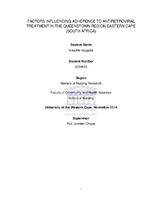| dc.description.abstract | BACKGROUND: Failure to adhere to antiretroviral therapy (ART) has negative
consequences not only for patients themselves, but for health systems. Strict adherence
to ART therapy together with modified life style will result in a positive outcome (WHO,
2003a).
AIM: The aim of the study was to describe factors that may influence adherence to ART
treatment.
METHOD: A quantitative research approach was used to conduct a survey using an
interviewer administered questionnaire in the Queenstown region in three clinics with
patients on ART. A random sample of 118 was selected out of a possible 594 patients.
The response rate was n=97 (80.5%). The majority were females, n=77 (79%) with most
of the respondents being 35-44 years, n=46 (47.4%) and single, n=76 (78%).
Social and economic results: Respondents were economically inactive (unemployed),
n= 49 (50, 5%) and n=40 (41.2%) on disability grant with no significant association
between the employment status and acceptance of antiretroviral treatment. Males had
higher rates for acceptance of ART and with more males n= 8/20 (40%) as compared to
women n= 13/77 (16.8%) stating that they accepted their outcome (X2=5, p=.035). High
levels of emotional support were reported n= 79 (81.4%).
HEALTH CARE SERVICE RESULTS: Only n=3 (3.1%) of the respondents reported to have their
own transport, resulting in 72 respondents (74.2%) reporting that it was difficult to comply
with treatment if they lived far from the clinic.
CONDITION RELATED RESULTS: Only n= 17 (17.5%) respondents reported that they suffered
from OIs in the last six months with Diarrhoea being the most common n= 93 (94.9%).
Patient related results: Only 7 respondents reported to take alcohol at an average of
1.4 bottles a week. About n=81 (83.5%) of respondents reported difficulty in taking
treatment at work.
TREATMENT RELATED RESULTS: The majority of respondents n= 43 (44.3%) reported to be
on their current regiment for less than a year. Almost 100% of the respondents had correct
knowledge of their treatment regimen and prescriptions for OIs and ART therapy. Most of
the respondents (90.7%) agreed with the statement, that HIV patient's family should
facilitates their intake of medication and this was significantly higher in respondents who
have not accepted their diagnosis and the need to be on medication for the rest of their
lives.
CONCLUSION: Treatment adherence management should take into consideration the
factors that may influence adherence | |

